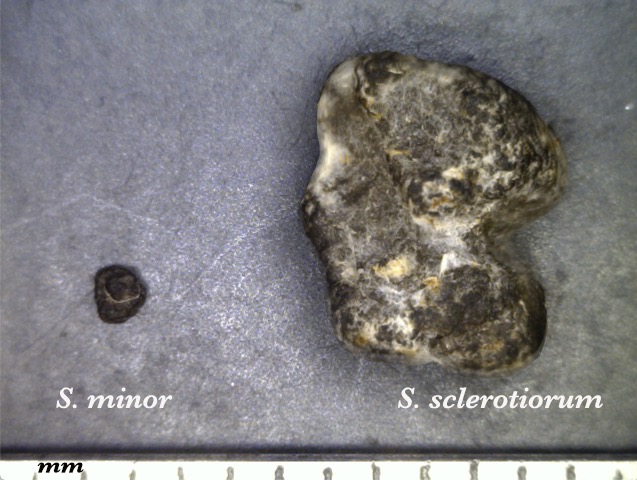
|
|
|
|

|
|||
|
|
|||
|
|
|||
Successful management of any plant disease is achieved by targeting one or more vulnerable stages in the disease development cycle. For Sclerotinia drop of lettuce, caused by the fungi Sclerotinia minor and S. sclerotiorum, this point of attack would be the dark fungal structures called sclerotia. At crop maturity, sclerotia produced on infected plants by these pathogens will be incorporated into soil along with crop debris as the field is prepared for planting the next crop. Sclerotia serve the same purpose that seeds do for plants; that is, they allow these fungi to carry over in soil in a dormant state until conditions become favorable for their germination and growth. Over the past several years of fungicide evaluation trials, one or two fungicide applications to the bed surface beginning at seeding or after thinning have provided at best a 50 to 60% reduction in dead plants compared to plots not receiving fungicide treatments. In a comparison of fungicide efficacy data from 2011 to 2016 field trials, the average reduction of dead lettuce plants on beds containing Sclerotinia minor was 54, 52, 43, 42, 39, 31, and 30%, respectively, for plots treated with Endura (boscalid), Merivon (fluxapyroxad + pyraclostrobin), Fontelis (penthiopyrad), Kenja (isofetamid), Rovral (iprodione), Cannonball (fludioxonil), and Contans (Coniothyrium minitans). On beds infested with Sclerotinia sclerotiorum, the mean reduction of dead plants in the same six trials was 63, 55, 51, 45, 41, 40, and 23%, respectively, for plots treated with Contans, Merivon, Kenja, Rovral, Endura, Cannonball, and Fontelis. These data show that the degree of fungicide effectiveness often depends on the species of Sclerotinia present in soil. However, for both species of Sclerotinia, application of fungicides to the bed surface will prevent germination of sclerotia at or near the soil surface, thus reducing lettuce plant infection and death 

To contact Mike Matheron go to: matheron@ag.arizona.edu.
|
|||
| Back | |||
|
For questions or comments on any of the topics please contact Marco Pena at the Yuma Agricultural Center.
|
|||
|
Home |
Cotton
| Veggies |
Forages
| Grains
| Citrus |
Crop x Crop
Insects | Diseases | Weeds | Pesticides | Economics | News | Weather | Research | Photos | Contacts | General Info. Copyright © 2001 University of Arizona, College of Agriculture and Life Sciences Webmaster: Al Fournier (acis@ag.arizona.edu) |
|||